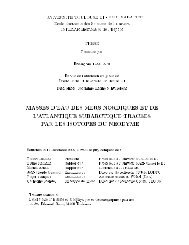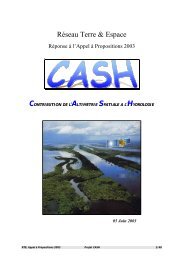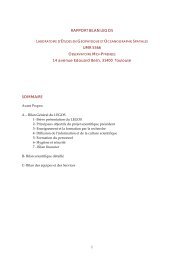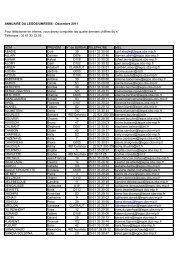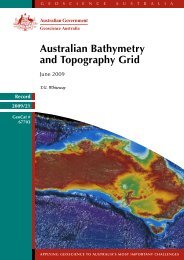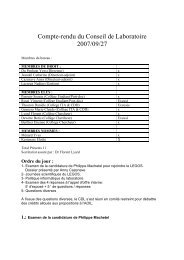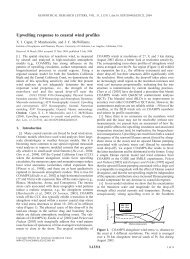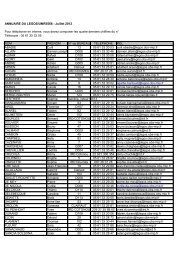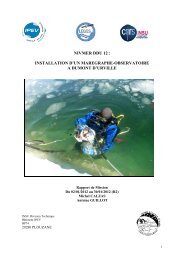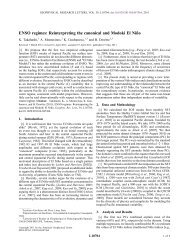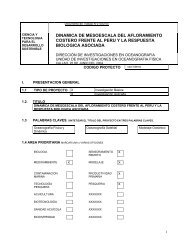Chaigneau and Pizarro - LEGOS
Chaigneau and Pizarro - LEGOS
Chaigneau and Pizarro - LEGOS
You also want an ePaper? Increase the reach of your titles
YUMPU automatically turns print PDFs into web optimized ePapers that Google loves.
C05014 CHAIGNEAU AND PIZARRO: CIRCULATION OF THE EASTERN SOUTH PACIFIC<br />
6 days are equivalent to those of the tropical Pacific [Bauer<br />
et al., 1998] <strong>and</strong> close to the 2–7 days observed in the<br />
California currents [Swenson <strong>and</strong> Niiler, 1996].<br />
[28] Corresponding to the integral timescales, we can<br />
determine the integral length scales in each direction L =<br />
(Lu, Lv) using [Taylor, 1921; Knudsen <strong>and</strong> Katz, 1958]<br />
ffiffiffiffiffiffi<br />
L ¼ u02 q<br />
T;<br />
ffiffiffiffiffiffi<br />
where u02 p<br />
represents the st<strong>and</strong>ard deviation of the turbulent<br />
flow velocity. The mean Lagrangian length scales <strong>and</strong> the<br />
associated errors determined by Student’s t test, with a<br />
significance level of 5%, are 40.7 ± 5.4 km for the zonal<br />
direction <strong>and</strong> 29 ± 3.4 km for the meridional direction<br />
(Table 2), again showing the anisotropic nature of the<br />
study region. In the California Current region, Swenson<br />
<strong>and</strong> Niiler [1996] estimate typical space scales of 16–59 km.<br />
Depending on the subregion of the California Current Systems,<br />
the turbulent flow can show elongated time <strong>and</strong> length<br />
scales along both the zonal <strong>and</strong> meridional directions<br />
[Swenson <strong>and</strong> Niiler, 1996]. In this study, we have also<br />
shown the anisotropic character of the surface ocean in<br />
the eastern South Pacific; on average, both temporal <strong>and</strong><br />
spatial scales were elongated in the zonal direction.<br />
4.2. Lateral Dispersion <strong>and</strong> Diffusivity<br />
[29] The large mixing rate in a turbulent flow is due to the<br />
fact that the fluid particles gradually diverge from their<br />
initial location. Taylor [1921] has shown that, in steady <strong>and</strong><br />
homogeneous turbulence withoutffiffiffiffiffiffiffi mean flow, the zonal <strong>and</strong><br />
meridional particle dispersion X02 p pffiffiffiffiffiffiffi<br />
pffiffiffiffiffiffiffi<br />
=( X 0 2,<br />
Y 0 2)<br />
from<br />
its origin can be related to the velocity autocorrelation<br />
function by [e.g., Kundu <strong>and</strong> Cohen, 2000; Zhang et al.,<br />
2001; Martins et al., 2002]<br />
X02 ðÞ¼2 t u02 t<br />
Z t<br />
0<br />
1<br />
t<br />
t<br />
RðtÞ RðÞ 0<br />
dt;<br />
where the overbar denotes ensemble average of individual<br />
particles <strong>and</strong> X 0 = (X 0 , Y 0 ) is the Lagrangian position<br />
inferred by u 0 =(u 0 , v 0 ). In practice, if the statistics are<br />
stationary, the ensemble average is replaced by an average<br />
in time.<br />
[30] Figure 6a shows the zonal <strong>and</strong> meridional dispersion<br />
of the drifters due to both velocity components. If t is small<br />
compared to the autocorrelation scales, the autocorrelation<br />
function R tends to R(0) (Figure 5b) <strong>and</strong> the initial<br />
dispersion increases linearly with time <strong>and</strong> is proportional<br />
to the intensity of turbulent fluctuations:<br />
rms X 0<br />
ffiffiffiffiffiffiffi<br />
ð Þ ¼ X02 q ffiffiffiffiffiffi<br />
¼ u02 p<br />
t:<br />
Figure 6a shows effectively that for t < 3 days, the zonal <strong>and</strong><br />
meridional dispersions increase linearly with time, <strong>and</strong> that<br />
for t < 8 days, they exhibit the same characteristics.<br />
[31] For a long time t,<br />
rms X 0<br />
ffiffiffiffiffiffiffi<br />
ð Þ ¼ X02 q ffiffiffiffiffiffiffiffiffiffiffiffiffiffiffiffi<br />
¼ 2u02 p<br />
T t;<br />
where T =(T u, T v) is the integral timescale. Using T u =<br />
5.9 days <strong>and</strong> T v = 3.5 days, Figure 6a shows that the<br />
10 of 17<br />
dispersion of the drifters are close to the ‘‘r<strong>and</strong>om walk’’<br />
regime predicted by Taylor [1921] for lags between 10<br />
<strong>and</strong> 100 days. This relationship has been also observed in<br />
other ocean basins [e.g., Zhang et al., 2001; Martins et<br />
al., 2002]. For times longer than 100 days, the number of<br />
data drops drastically (Figure 6b) from around 350 for<br />
short times to around 120 for a lag of 200 days, <strong>and</strong> we<br />
have less confidence in the particle dispersions showing a<br />
plateau. After 100 days, the turbulent flow has displaced<br />
the drifters an average of 320 km zonally <strong>and</strong> 200 km<br />
meridionally from their origins. This result is consistent<br />
with the anisotropic nature of the turbulent flow observed<br />
in our study region.<br />
[32] The diffusivity K = (Ku, Kv) in a problem of<br />
turbulent dispersion corresponds to the rate at which the<br />
magnitude of X 0 =(X 0 , Y 0 ) increases with time <strong>and</strong> is given<br />
by [Martins et al., 2002; Kundu <strong>and</strong> Cohen, 2000]<br />
KðÞ¼ t<br />
1 d<br />
2 dt X02 Z<br />
¼ u02 t<br />
0<br />
RðtÞ Rð0Þ dt:<br />
K is computed from the normalized autocorrelation<br />
functions <strong>and</strong> therefore the theoretical diffusivities are<br />
expected to converge to a constant value after some integral<br />
timescales T. Analyzing the two limit conditions<br />
t T : KðÞ t u0 2 t<br />
t T : KðÞ t u0 2 T;<br />
C05014<br />
initially the diffusivity increases linearly with time, while<br />
for long times the diffusivity tends to a constant value<br />
depending on the integral timescale T.<br />
[33] The black lines in Figure 7 correspond to the<br />
diffusivities derived from the 353 independent drifter trajectories<br />
(section 4.1). The general forms of the curves are<br />
dominated by the form of the integrated normalized functions<br />
(Figure 5b), with a sharp increase for short times,<br />
followed by a plateau <strong>and</strong> then a decrease for longer times<br />
due to saturation <strong>and</strong> the negative values of the functions<br />
(Figure 5a). The product of the velocity variances by the<br />
integral timescales leads to Ku = (4.9 ± 0.5) 10 7 cm 2 s 1<br />
<strong>and</strong> Kv = (2.6 ± 0.3) 10 7 cm 2 s 1 (Table 2). Averaging the<br />
diffusivity curves over the saturation plateau between 40–<br />
70 days <strong>and</strong> 15–30 days in both zonal <strong>and</strong> meridional<br />
directions (bold black lines, Figure 7), we obtained, in the<br />
r<strong>and</strong>om walk regime, Ku =5 10 7 cm 2 s 1 <strong>and</strong> Kv =2.7<br />
10 7 cm 2 s 1 , in the range of the preceding error values.<br />
[34] To increase the realizations <strong>and</strong> the number of<br />
degrees of freedom, we reinitialized the trajectories every<br />
30 days (this value is much longer than the 3–6 day<br />
decorrelation timescale), as done in previous studies [Colin<br />
de Verdiere, 1983; Poulain <strong>and</strong> Niiler, 1989; Martins et al.,<br />
2002]. New autocorrelation functions (not shown) <strong>and</strong><br />
diffusivities (gray lines, Figure 7) are determined for each<br />
velocity component. Although meridional diffusivity is<br />
slightly reduced by this procedure, the results are quite<br />
close to those obtained for the initial trajectories (Table 2).<br />
For the r<strong>and</strong>om walk regime (t T), <strong>and</strong> averaging over<br />
the same zonal <strong>and</strong> meridional plateaus (40–70 days <strong>and</strong>





